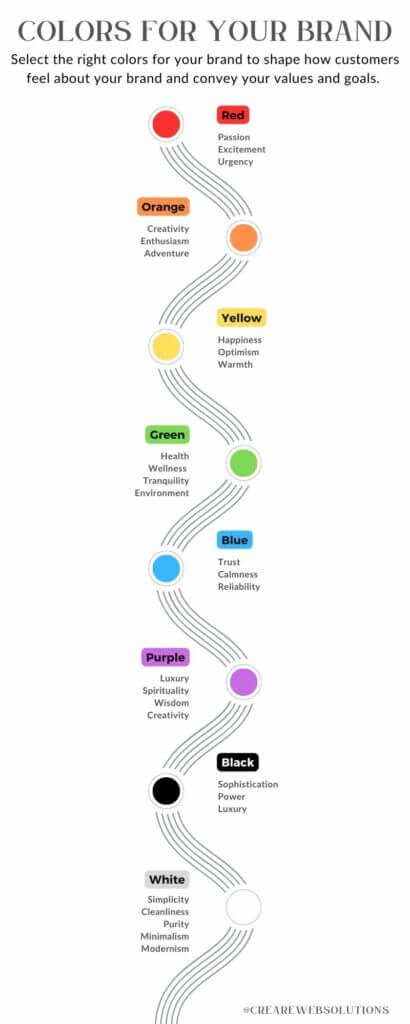Rolling out of bed this morning, I immediately headed to the bathroom to take my thyroid medication and brush my teeth. If I don’t start my day this way, I’ll get sidetracked and forget one of those steps—it’s happened more times than I care to admit.
Then, I make coffee and make sure my oldest has eaten breakfast and packed his bag for school. Once he’s on the bus, it’s time to get dressed.
Getting dressed.
What to wear? Do you ever stand at your closet, staring, wondering what outfit best fits the day ahead? I check the weather and my calendar to decide.
Do I need to look polished for a meeting?
Am I staying in, working behind the scenes, or out and about?
The truth is, choosing what to wear is more than just an outfit—it’s part of your personal brand.
How do you want to be perceived?
What impression do you want to make?
Just like clothing choices affect how you present yourself to the world, the colors you choose for your brand have the same impact.
Selecting the colors for your brand is about more than aesthetics. It’s about how you want to be seen. What emotions do you want to convey? What kind of customer are you trying to attract?
Colors define your brand’s identity. They make it memorable in a crowded market. So, how do you choose the right ones?
There are endless colors to choose from, so let’s break it down. Let’s look at different color families, the emotions they evoke, the industries they suit, and the customers they attract.
Using Warm Colors for Your Brand
Warm colors—red, orange, and yellow—bring energy and excitement to your brand. If you’re looking to attract spontaneous and impulsive customers who crave happiness, passion, and enthusiasm, colors from this family will help.
Red
Red evokes feelings of passion, excitement, and even urgency. It’s a color that grabs attention and creates energy. Red is great for brands looking to trigger strong emotions and attract customers ready to act quickly. It’s often used in the food, sports, and entertainment industries for that reason.
Yellow
Yellow is the color of happiness, optimism, and warmth. It attracts customers looking for joy and affordability. Brands that want to project friendliness and cheerfulness often use yellow. It’s common in businesses targeting children, like toys, or budget-conscious consumers, like fast food.
Orange
Orange combines the energy of red with the friendliness of yellow. It symbolizes creativity, enthusiasm, and adventure. Bold, spontaneous customers are drawn to orange, which is why brands in fitness, entertainment, and outdoor activities often choose it.
Using Cool Colors for Your Brand
Cool colors tend to create a calmer, more thoughtful vibe. They evoke trust, stability, and professionalism. Brands using these colors attract customers who are more deliberate in their decisions.
Blue
Blue is often used by corporate, financial, healthcare, and tech brands. It evokes feelings of trust, calmness, and reliability. If you’re trying to attract customers who value stability and security, blue tells them they can depend on you.
Green
Green is a natural fit for brands focused on health, wellness, and the environment. It’s associated with growth, health, and tranquility. If your brand promotes balance and harmony, green will appeal to eco-conscious or health-focused consumers.
Purple
Purple is less commonly used in branding, but it’s powerful when done right. It’s associated with luxury, spirituality, and wisdom, attracting customers who seek premium, high-end products. Purple is great for beauty, luxury, and creative brands wanting to convey sophistication and exclusivity.
Using Neutral Colors for your Brand
Neutral colors bring an element of timelessness and professionalism. They often signal a high-end, minimalist, or clean brand image.
Black
Black exudes sophistication and power. It’s a staple for luxury brands in industries like fashion, cosmetics, and technology. Black attracts customers seeking exclusivity and premium products. It also evokes feelings of strength and mystery.
White
White represents simplicity, cleanliness, and purity. It conveys calmness and openness, often used in industries like skincare, tech, and luxury fashion. Customers drawn to white value minimalism, cleanliness, and modernity. White also appeals to eco-conscious consumers looking for ethical and pure products.
Grey
Grey strikes a balance between black and white, offering neutrality and professionalism. It’s often used by brands in tech, automotive, and industrial sectors. Grey attracts practical, no-nonsense customers and conveys seriousness, balance, and reliability.
Brand Colors in Action
I asked Google what the top brands in the U.S. are, and after reviewing the list, I matched their colors to the feelings they evoke. Here’s a look at how those colors work in real life:
- Apple: Black & White. These colors convey simplicity and elegance, aligning with Apple’s minimalist, modern image.
- Microsoft: Red, Green, Blue, Yellow. These primary colors signal passion, growth, dependability, and friendliness.
- Google: Blue, Red, Yellow, Green. Similar to Microsoft, Google’s color palette communicates trust, urgency, happiness, and growth.
- Amazon: Black & Orange. Amazon uses black for its premium feel, paired with orange for energy and excitement.
- Walmart: Blue & Yellow. Walmart’s colors combine trust and friendliness, appealing to budget-conscious customers.
- Facebook: Blue. Facebook uses blue to foster trust and reliability.
- Verizon: Red & Black. These colors convey passion and power, promoting Verizon as a premium brand.
- Instagram: Purple, Red, Orange & Yellow. Instagram’s vibrant palette promotes creativity, energy, fun, and happiness.
- Starbucks: Green & White. Starbucks uses green for its eco-friendly, health-conscious message, with white adding simplicity and calmness.
- Tesla: Red, Black & Grey. Tesla’s colors represent passion, professionalism, and premium quality.

Have you Chosen the Right Colors for your Brand?
As you can see, the colors you choose for your brand aren’t just aesthetic choices. They are strategic decisions that shape how customers see you and feel about your brand. And, if they want to purchase from you or not.
If you’re unsure how to choose the right colors for your brand, connect with us and let’s work together to find something that resonates with you, and your audience.
Or, if you know exactly what colors you want to use, have you thought about the fonts that you’ll pair them with? If not, be sure to read this blog where we tackle all the things you need to think about when selecting the right fonts for your brand!
Before we go I’ll challenge you to start observing the brands around you, the ones you support, and the colors they are. And, if you already have colors you selected, without thinking about this, what are they? Do they match your company values? Are they attracting the right clients? I’d love to hear about it, so share your observations below!


